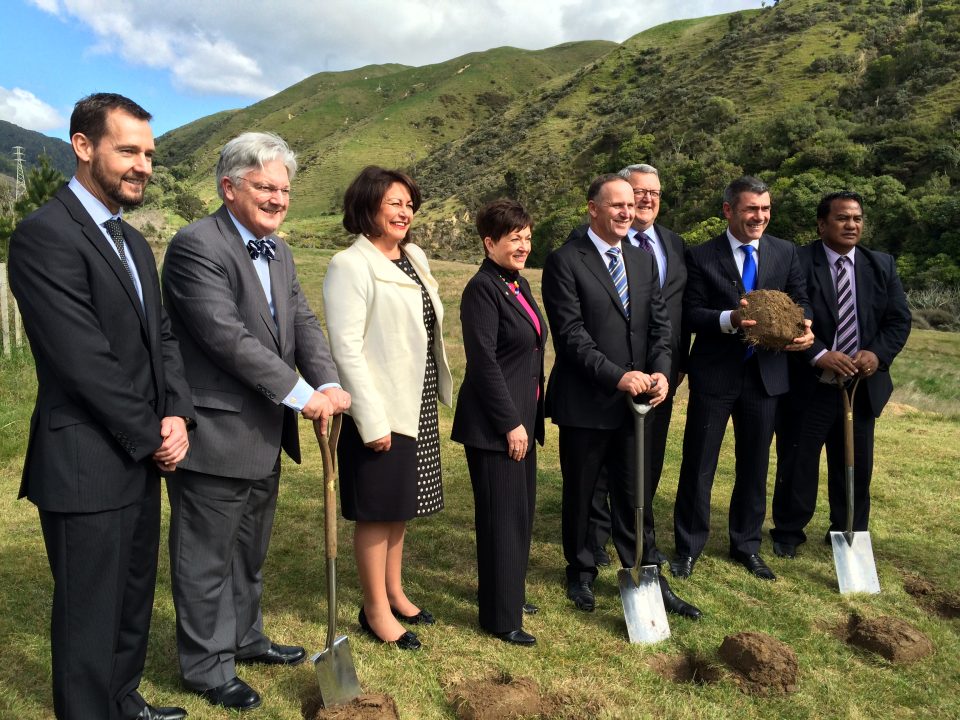Caption: At the very beginning and the Transmission Gully projects Sod-turning in September 2014 were from left: David Jurd, Leighton Contractors managing director; Ohariu MP Peter Dunne; Mana MP Hekia Parata; NZTA deputy chair Dame Patsy Reddy; Prime Minister John Key; Transport Minister Gerry Brownlee; Otaki MP Nathan Guy; and Ngati Toa chair Taku Parai.
By Peter Dunne.
Wellington’s long-awaited and controversial Transmission Gully Motorway opens to the public today (March 31, 2022) a mere 103 years after the MP for Otaki at the time proposed it be developed as a road for motor vehicles to commemorate the fallen soldiers of World War I.
The new 27-kilometre motorway, north of Wellington from Linden to McKays Crossing just north of Paekakariki, is a state-of-the-art project, incorporating the most modern design and safety features. In a first for New Zealand, it has its own radar system, like those operating on many European highways, to detect crashes and other road incidents and provide up-to-the minute information to motorists.
Speaking at the opening ceremony, Transport Minister Michael Wood waxed lyrical that; “Transmission Gully is one of the most significant and complex new roading projects ever undertaken in New Zealand … requiring innovative environmental and construction techniques.”
Yet only a few weeks ago, when Waka Kotahi [the New Zealand Transport Agency] did not open the road before Christmas as planned, Wood dismissed the project, which commenced construction in 2014, as a National-led government “botch-up”, an intemperate claim churlishly repeated by the Deputy Prime Minister after yesterday’s opening, where he had seemed to be very content sitting, smiling, and purring, in the front row of the dignitaries alongside Minister Woods.
I had the privilege of driving over Transmission Gully shortly after the opening ceremony. It is a spectacular four-lane motorway, a vast contrast to the current winding, accident prone Coastal Highway it replaces. It will cut journey times into and out of the capital, as well as providing safe earthquake access and egress. (Transmission Gully has been designed to withstand an earthquake of one in 2500-year severity). While it has been a long wait, the finished product is certainly worth it, and will be quickly embraced by those living here and everyone using it.
A game changer for regional growth
But aside from its impressive technical qualities and the substantial improvement it brings to driving conditions into and out of Wellington, Transmission Gully will be a game-changer in another respect as well. It is likely to be a massive boost to industrial and residential development to Wellington’s north, around the Porirua Basin and through to the Kapiti Coast.
And, with a new four-lane highway from Peka Peka (north of Waikanae) through to Otaki, currently about an hour’s drive north of Wellington, due for completion by the end of this year, the whole area should expand rapidly.
Once the railway line to Otaki and on to Levin is electrified – to allow suburban rail services to operate that far north – as promised over the next three years, the greater Wellington region should be able to look forward to a greater level of economic and population growth than ever before.
The problem with all this additional growth, though, is as some Wellington city local politicians keep pointing out, that it is likely to be at the expense of Wellington city. It is easy to see why – there is more residential and commercial space available to the north, the climate is more congenial, and improved road and rail links make the journey into Wellington less demanding.
But Wellington city has been dying a slow death for some years – a point former Prime Minister Sir John Key was roundly criticised for raising as far back as 2013. Nevertheless, Wellington’s CBD is a shadow of its former self, with prestige department store, David Jones, due to close around the middle of this year. Add to that the Covid lockdowns and the fact that most of the public servants who previously filled the inner city’s cafes, restaurants, bars, hairdressers, and other service businesses are still working from home, and the picture for Wellington businesses looks grim.
Moreover, in that context, the city’s projection of population growth of 80,000 for Wellington city over the next 30 years looks like ludicrous fantasy. Worse though, the Wellington City Council has now decided that to meet this fictional demand apartment blocks up to six stories high can now be built in residential areas, on a non-notified consent basis. It is kneejerk nightmare stuff, based more on trying to keep Wellington city as the central point of the growing wider region than common sense.
The opening of Transmission Gully confirms that the region’s future growth and development will not come from Wellington city.
The city’s future lies in being the centre of government, and the country’s cultural heartland, and the council needs to shift its focus accordingly. The Wellington region is too small, even if future population fantasies materialise, to continue to operate as five separate insular cities (Wellington, Porirua, Kapiti, Lower Hutt and Upper Hutt) the way it does at present.
The opening of Transmission Gully needs to become the catalyst for a new examination of the way the Wellington region works to get the maximum benefit from the new motorway. It is time for a fresh look at the viability of the region’s local government structure and whether a region of just 530,000 people needs a regional council and the five district councils.
Transmission Gully is about to dramatically change the Wellington region’s roading and transport landscape, and impact population growth and economic development for the future.
At her speech opening the motorway, the Prime Minister said it was an “engineering marvel” which will benefit the whole country, not just local communities, for generations to come.
But to become a reality, that will require local politicians to look beyond their own parochial patch and adopt a greater regional and national perspective to ensure those benefits are achieved.



